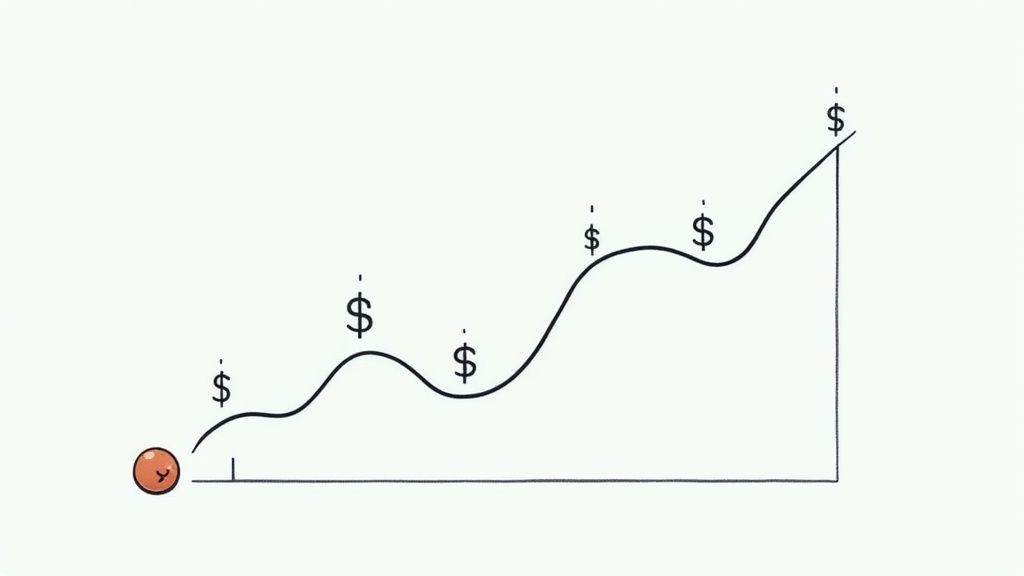What Is Dollar Cost Averaging? Your Investment Strategy Guide
Learn what is dollar cost averaging and how this strategy helps you invest consistently, reduce risk, and build long-term wealth. Discover the benefits now!

At its core, dollar cost averaging is an investment strategy that takes the guesswork and emotion out of buying into the market. It’s a simple but powerful idea: you invest a fixed amount of money at regular intervals—say, every week or month—no matter what the market is doing. This disciplined approach can actually turn market volatility into an advantage.
Unpacking Dollar Cost Averaging

Let’s use a simple analogy: buying gasoline. Instead of trying to time your fill-ups perfectly to catch the lowest price, imagine you just decide to put $50 worth of gas in your car every single Friday.
- When gas prices are high, your $50 gets you fewer gallons.
- But when prices drop, that same $50 buys you more gallons.
After a few months, you’ve smoothed out what you pay per gallon. Dollar cost averaging (DCA) applies this exact logic to investing in assets like stocks or ETFs. You commit to a fixed-dollar amount on a set schedule, which automatically makes you buy more shares when they're cheap and fewer when they're expensive.
The Power of Consistency
This systematic approach helps investors sidestep the classic trap of emotional decision-making. The fear that grips you during a market downturn can cause paralysis, while the excitement of a rally might tempt you to buy right at the peak. DCA gives you a clear, automated path forward, taking those gut reactions out of the equation.
The core principle is simple: turn market volatility from an enemy into an ally. Instead of fearing price drops, a DCA investor sees them as opportunities to acquire more of an asset at a discount.
This isn't some new-fangled idea. The strategy was famously detailed by the legendary investor Benjamin Graham in his 1949 book, The Intelligent Investor. He explained how investing a fixed sum at regular intervals reduces the whiplash from market swings. By doing this, an investor can potentially lower their average cost per share over the long run. You can find plenty of resources online to explore the history and mechanics of this time-tested strategy.
So, what is dollar cost averaging? Ultimately, it's about committing to a plan and sticking with it. It’s a way to build a position in the market methodically, transforming the chaos of daily price swings into a predictable, manageable process for long-term wealth creation.
DCA in Action vs a Single Investment
Let's see how investing $400 over four months with DCA compares to a single $400 lump-sum investment in a volatile market. The table below shows how DCA can help you acquire more shares for the same amount of money when prices fluctuate.
As you can see, the DCA investor took advantage of the price dip in months 2 and 3, ending up with 52.5 shares. The lump-sum investor, who bought everything at the start, only acquired 40 shares for the same $400. This example highlights how DCA can help lower your average cost per share and build a larger position over time, especially when the market is choppy.
Why Smart Investors Use Dollar Cost Averaging

Beyond the simple math, the real magic of dollar cost averaging is psychological. It’s an incredibly effective shield against our own worst instincts—the fear and greed that so often lead investors to make emotionally charged, and frankly, bad decisions.
This strategy helps neutralize that internal pressure to pile in during a market frenzy or panic-sell during a dip. When you automate your investments, you’re committing to a disciplined plan, which is one of the absolute cornerstones of building wealth over the long haul.
The greatest challenge for investors isn’t picking the right asset; it’s sticking to a plan. Dollar cost averaging transforms investing from an emotional rollercoaster into a calm, systematic habit.
This approach makes investing feel accessible and a whole lot less intimidating, especially if you're just starting out. It completely removes the need to perfectly time the market—a feat that’s virtually impossible, even for seasoned pros. Instead, you get to focus on your long-term goals without getting sidetracked by the daily market noise.
Fostering Healthy Financial Habits
By setting up regular, automatic contributions, dollar cost averaging builds what might be the single most important financial habit of all: paying yourself first. This simple discipline ensures you are consistently growing your assets over time, month after month.
This strategy delivers a few key advantages:
- Reduces Emotional Stress: Having a predefined plan brings peace of mind. It takes the anxiety out of making decisions during those inevitable volatile periods.
- Promotes Discipline: Automating your buys enforces consistency. It stops you from hitting pause on your investments when markets are down—which, ironically, is often the best time to be buying.
- Builds Long-Term Focus: It shifts your entire perspective away from worrying about short-term market swings and toward the steady, patient accumulation of assets over many years.
When you embrace DCA, you're not just investing in assets; you're investing in a process that protects you from your own behavioral pitfalls. If you're looking to build an even more resilient financial plan, you can discover more tips on how to diversify an investment portfolio in our related guide. For those curious about how this applies to digital assets, exploring other passive Bitcoin strategies, including dollar cost averaging), can offer some great additional context.
DCA vs. Lump-Sum Investing: Which Is Right for You?

It's the classic investing dilemma: go all-in at once, or ease your way into the market over time? This is the core of the debate between lump-sum investing and dollar cost averaging (DCA). The honest answer is that there’s no single “best” strategy for everyone.
The right choice hinges entirely on the market environment, your personal finances, and—most importantly—your stomach for risk. Let’s break down when each approach shines.
The Case for Each Strategy
Lump-sum investing is straightforward: you invest your entire capital in one single transaction. This move often pays off handsomely in a strong, upward-trending market. By getting your money working from day one, you maximize your time in the market and stand to capture bigger gains during a sustained bull run.
In contrast, dollar cost averaging acts as an emotional and financial shock absorber. It’s a powerful risk-management tool that excels when markets are choppy or heading downward. By investing smaller, fixed amounts over time, you avoid that sinking feeling of putting all your cash in right before a crash. Instead, you average down your purchase price as the market dips.
Choosing Your Strategy: DCA vs. Lump-Sum
Deciding between these two powerful approaches often comes down to a trade-off between maximizing potential returns and managing psychological stress. This table breaks down the core differences to help you see which one aligns better with your goals and temperament.
Ultimately, both strategies are valid ways to build wealth. The key is to understand the environment where each one thrives and how it fits your personal investing style.
What the Data Says
If we look purely at historical returns, the data often gives the edge to lump-sum investing. Why? Because over the long haul, markets have historically trended up. More money in the market for more time usually results in a bigger payoff.
A well-known Northwestern Mutual study found that lump-sum investing beat dollar cost averaging roughly 75% of the time over rolling 10-year periods in all-equity portfolios.
But raw numbers don't tell the whole story. The "best" strategy on paper isn't the best one for you if it keeps you up at night. The psychological power of DCA is immense; it turns investing into a calm, repeatable habit. For many, avoiding the potential regret of a poorly timed lump-sum move is worth more than chasing slightly higher returns.
To get a better handle on how different scenarios could play out for your own portfolio, it helps to model potential futures. Our guide on using a Monte Carlo simulation for your finances can show you how to do just that.
Making the Final Call
So, how do you decide? It boils down to a personal calculation of risk versus reward.
- Consider Lump-Sum If: You have a high tolerance for risk, a long time horizon, and a strong conviction that the market is unlikely to see a major correction soon.
- Consider DCA If: You're more risk-averse, want to smooth out the bumps of a volatile market, or if the amount you're investing is large enough that a sharp decline would cause you significant stress.
The most important thing is to pick a strategy you can stick with, through thick and thin, without letting fear or greed knock you off your long-term plan.
Putting Dollar Cost Averaging into Action with PinkLion
Knowing the theory behind dollar cost averaging is great, but putting it into practice is how you actually build wealth. With PinkLion, setting up an automated investment plan is refreshingly simple, turning this powerful strategy into a set-it-and-forget-it habit. We designed our platform tools to make disciplined investing feel completely effortless.
Ready to start? The first step is to find the recurring investment feature inside your PinkLion dashboard—this is the command center for your DCA plan. From there, it only takes a few clicks to automate your contributions and put your financial goals on autopilot.
A Step-by-Step Guide to Automating Your Investments
Implementing dollar cost averaging isn’t about timing the market or making complicated moves. It’s all about consistency. PinkLion boils this down to a simple, three-step process you can finish in just a couple of minutes.
- Select Your Asset: First, pick the investment that matches your long-term goals. This could be anything from a broad market ETF that tracks the S&P 500, a specific growth stock you believe in, or a diversified mutual fund.
- Define Your Amount: Next, decide on a fixed dollar amount you can comfortably invest on a regular basis. Whether it’s $50, $250, or $1,000, the key is choosing a figure you can stick with, month in and month out.
- Set Your Schedule: Finally, align your investments with your own cash flow. PinkLion gives you the flexibility to choose a weekly, bi-weekly, or monthly schedule, making it easy to invest right after you get paid.
This screenshot shows just how clean and intuitive the setup is on PinkLion.

As you can see, the platform makes it dead simple to pick your investment, lock in an amount, and set the frequency. We’ve removed all the friction from the process.
The goal is to move from good intentions to consistent action. By automating the process, PinkLion ensures your investment plan keeps working for you, even when life gets busy and you're not actively thinking about it.
Once your plan is locked in, PinkLion takes over, automatically executing your trades according to the schedule you set. This ensures you’re consistently buying into the market, taking full advantage of price fluctuations without letting emotion or hesitation get in your way. It’s a disciplined approach made easy.
Common Mistakes to Avoid When Using DCA
Dollar cost averaging is a fantastic strategy, but it's not a magic wand. A few common (and totally avoidable) mistakes can easily trip you up, slowing down your progress and undermining the whole point of the system.
Let's walk through the big ones so you can sidestep them.
The single biggest error investors make? Stopping contributions when the market drops. It feels completely backward, I know. Your gut screams "danger!" But a falling market is exactly when DCA does its best work. This is your golden opportunity to snap up more shares for the same amount of money, which pulls your average cost down significantly. Hitting pause out of fear cancels out the strategy's main advantage.
The real test of dollar cost averaging isn't just investing consistently when it's easy. It's having the discipline to stick with it when it’s hardest. Think of a market downturn as a sale, not a signal to run for the hills.
Ignoring Your Strategy
Another common pitfall is the "set it and forget it" trap. Automation is a huge help, but your life isn't static. Your financial goals, income, and risk tolerance can shift over time. A plan that was perfect for you five years ago might need a tune-up today.
You should give your strategy a quick review every so often to make sure it still fits your long-term vision. This isn't about nervously reacting to every news headline. It's about making thoughtful adjustments. To pull this off, you need to learn how to analyze market trends without letting the short-term noise throw you off course.
Finally, don’t let fees eat your lunch. If you're making tiny, frequent investments on a platform that charges high per-trade costs, those fees can quietly drain your returns.
Here’s how to keep costs low:
- Choose a low-cost platform: Look for brokers like PinkLion that offer commission-free trades on stocks and ETFs.
- Mind the expense ratios: High management fees on funds act like a constant drag on your performance.
- Consolidate your investments: Depending on the fee structure, a single monthly investment might be far more cost-effective than four weekly ones.
Frequently Asked Questions About Dollar Cost Averaging
Even after you get the hang of a new investment strategy, some practical questions always pop up. It's one thing to understand a concept, but another to feel confident putting your money behind it.
Let's walk through some of the most common questions investors ask about dollar cost averaging. My goal here is to give you clear, straightforward answers so you can start using this powerful technique effectively.
Does Dollar Cost Averaging Work for All Types of Assets?
Yes, the core idea behind dollar cost averaging is incredibly flexible. It works for just about any asset that has a fluctuating price.
This includes the classics:
- Individual Stocks: Buying shares of a company you believe in over time.
- ETFs (Exchange-Traded Funds): A perfect match for DCA. You can buy into broad indexes like the S&P 500, smoothing out the bumps across hundreds of companies at once.
- Mutual Funds: A traditional and popular choice for setting up automated, regular investments.
The main benefit is always the same: you average out your purchase price by investing a set amount on a regular schedule. This helps you avoid the classic mistake of putting all your money in right at a market high. It’s even a sensible approach for newer digital assets, like investing in Sports NFTs, where price swings can be even more dramatic.
How Often Should I Invest When Using This Strategy?
This is a great question, but the answer is simpler than you might think: consistency is far more important than frequency. The best schedule is the one you can actually stick to, no matter what the market is doing.
For most people, that means investing weekly, bi-weekly, or monthly—whatever aligns best with your paycheck and budget. While investing more often (say, weekly instead of monthly) might smooth your average cost a tiny bit more, the long-term difference in your returns is usually pretty small. The real key is to pick a schedule and stick with it.
The power of dollar cost averaging comes from discipline, not perfect timing. Whether you invest $100 every Friday or $400 on the first of every month, the crucial element is that you do it consistently through all market conditions.
Can I Use Dollar Cost Averaging for Cryptocurrency?
Absolutely. In fact, given the extreme volatility you often see in assets like Bitcoin and Ethereum, dollar cost averaging can be a fantastic way to enter the crypto market without losing sleep.
By making regular, fixed-dollar purchases, you sidestep the temptation to pour a huge sum in at a temporary peak—a common and costly mistake. Instead, you steadily build your position at an averaged cost, automatically buying more coins when prices are low and fewer when they're high. It’s a disciplined approach that turns volatility into an advantage, and many crypto exchanges now offer recurring buy features designed for exactly this purpose.
Ready to put dollar cost averaging into action? With PinkLion, you can automate your investments in minutes, track your entire portfolio in one place, and use professional-grade tools to optimize your strategy for the long term. Start for free and see how easy disciplined investing can be.
